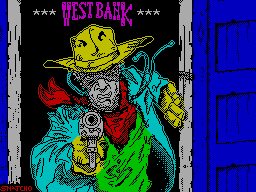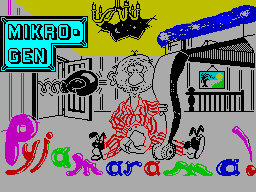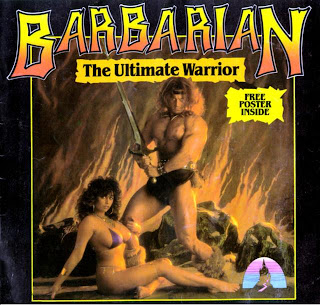Now this classic game will bring back plenty of memories for lots of you ZX Spectrum gamers.
Starquake was released by the delightfully named Bubblebus software late on in 1985 to much critical acclaim.
The developer of the game Steve Crow was already well known for his previous (and very good) efforts Factory Breakout and Wizards Lair.
Steve would go on to develop more excellent titles for the Spectrum over the next few years.
Starquake was an arcade adventure - mixing arcade action and platform gaming with a large dollop of humour to create a nice game full of challenge and character.
As usual it was up to you to save the day, in this case our lovely planet Earth.
The inlay text of the games cassette gave a nice overview of what lay ahead:
"Message has just reached Earth of an unstable planet emerging from a black
hole somewhere at the edge of the galaxy. If the core of this planet is not
rebuilt it will implode causing the whole universe to go "Ka Boomf!" -
Strewth, a Starquake..."
This was obviously not very good news, so a hero was sent to this rogue planet (a little being called BLOB - or Bio-Logically Operated Being) to rebuild the core of this rogue planet and avert the impending disaster. Game on!
This game was presented in age old arcade adventure style. The screens flicked between each other and the majority of the action occurred in a system of caverns below the suface of the planet.
Our hero was a creature with some of the usual abilities who could go left and right and had a nice line in falling (for moving downwards).
It was possible to propel Blob upwards too, by use of his platform laying device. In this novel twist platforms could be used to prevent a fall or be 'stacked up' to create a vertical stairway.
Once laid the platforms soon faded away (sort of super quick bio-degradable), crumbling away to dust leaving poor Blob unsupported in mid air (if you had not made it onto more a more solid piece of rock in the meantime).
You began the game (in classic arcade game style) with four lives, a stockpile of platforms and some ammo.
The top of the screen displayed valuable data such as lives remaining, energy levels (each life had an energy bar) which was sapped by colliding with any of the nasties roaming around the caverns, and your platform and ammunition levels.
To aid you in your planetary quest it was also possible to jump on 'hopper pads' to move around the screens. These hover pads allowed you to zip around the screens in all directions, thus saving on your platform stocks.
The downside was that you had to park the pad and leave it if you wanted to collect any items (such as extra ammo, platform packs, energy boosts and even the odd extra life).
You could also move around using the built in teleport system and jump from one area of the planet to another. When you entered a teleport, it informed you of its teleport code and requested a destination code to allow it to transport you to another teleport booth.
The teleport network was a really great feature - once you had played the game enough and found the codewords to all six teleports.

The whole game was large and was smattered with lots of different features and items.
Security doors barred you way in certain areas (usually blocking your path to an essential 'core piece') and you would have to find the key code to open it. Little pyramids could be used to trade in items you were currently holding for a more useful item and an access card would allow you one time access (get it?) to any door.
There were also secret passages, zap rays and 'breakable bridges' which would prevent upwards passage, but could be broken by falling onto them from a great height.
The variety of objects, masses of locations and imaginative graphics marked Starquake on the ZX Spectrum as a unique and playable game.
On Release:
Steve Crow was already building a good reputation for himself on the back of his previous games and this one made him a household name (well in ZX Spectrum households anyway). Gamers loved the frantic mix of arcade and platform action that Starquake offered. This coupled with the puzzle solving elements, polished presentation and slightly wacky graphical style ensured that Steve Crow's game was a big hit. Speccy gamers bible Crash magazine scored it with a very nice 96% praising it's gameplay and technical acheivement.
The test of time:
This is a playable and fun game. The visuals used in the game still work, and the action is as frenetic as ever. The central character BLOB is a nice little being, and the strategy you have to employ (use of platforms, hover pads, learning codes etc) makes Starquake a challenging yet playable experience. A lot of people have fond memories of this game - and here in the land of ZX Spectrum Games we can see why. This is a bona fide classic game.
We recommend getting hold of the real Sinclair hardware - but if not then download a ZX Spectrum emulator and download Starquake for the ZX Spectrum. Alternatively you could try and play it online.
GENRE: Arcade Adventure
RELEASE DATE: Tail end of 1985
RELEASED BY: Bubblebus Software
DEVELOPER(S): Steve Crow
PRICE: £7.95 - UK
Classic Arcade Gaming:
Classic Games, Arcade Games and ZX Spectrum Games























